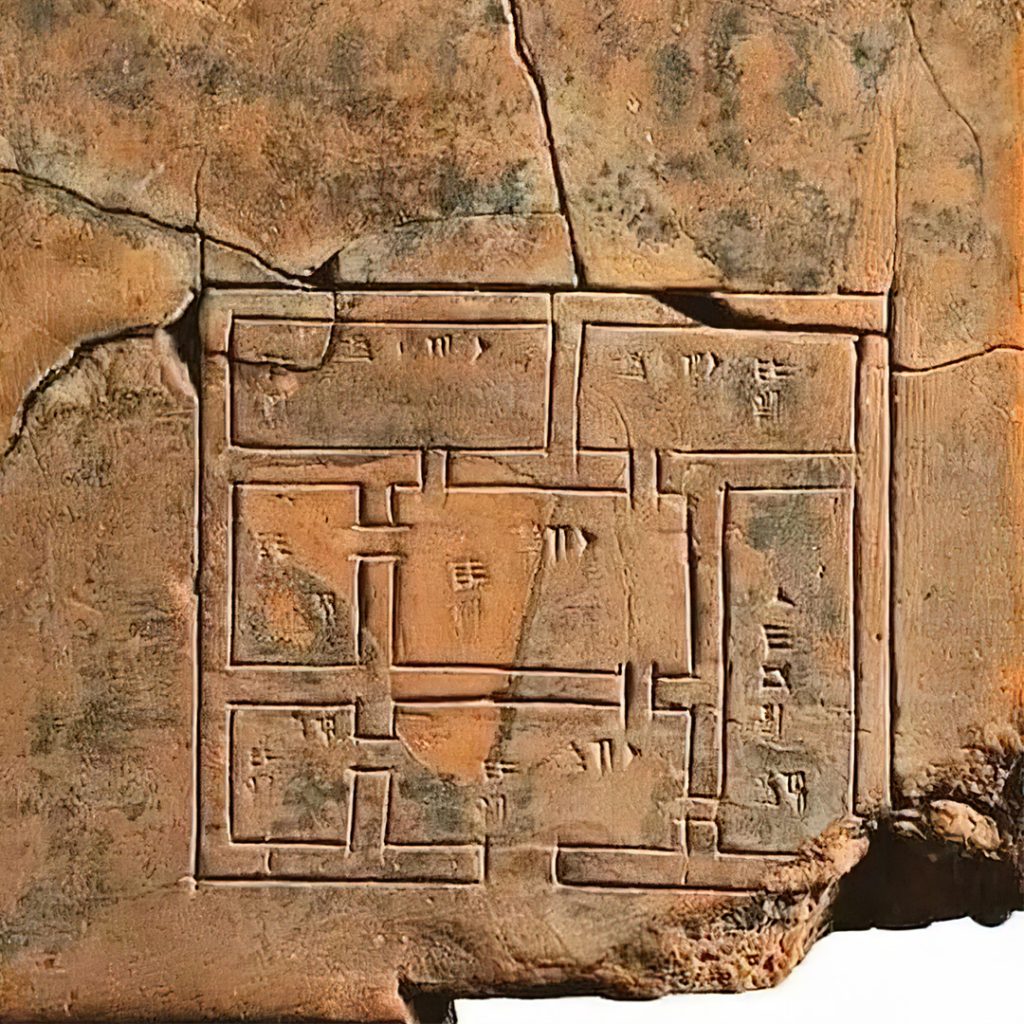This extraordinary Sumerian house plan, estimated to be nearly 5,000 years old, provides a fascinating glimpse into the architectural ingenuity of the Ur III period (circa 2112–2004 BCE). Carved onto a clay tablet discovered in the ancient city of Umma, this artifact highlights the sophistication of early urban planning and offers invaluable insights into the daily lives of its creators.

Architectural Features
Central Courtyard Design
At the heart of the plan lies a residential structure meticulously designed around a central courtyard—an iconic element of Sumerian urban architecture. This courtyard not only served as a shared family space but also enhanced the dwelling’s ventilation and access to natural light. Such a design reflects an advanced understanding of how to harmonize living spaces with environmental factors. By integrating functionality with comfort, the Sumerians demonstrated an architectural foresight that was exceptional for its time.
Use of Cubits for Measurements
One of the most striking details of this clay tablet is its use of cubits as a standardized unit of measurement. These dimensions reveal the sizes and proportions of the various rooms, suggesting a well-organized layout designed to meet the practical needs of the inhabitants. The consistent application of cubits points to a systematic approach to construction, showcasing a high degree of sophistication in building practices. Such precision highlights the Sumerians’ focus on efficiency and uniformity, principles that would influence architectural standards for generations.
Representation of Walls and Doorways
The house plan uses parallel lines to represent walls, while doorways are distinctly marked to provide a clear and detailed depiction of the structure’s layout. This method of documentation underscores the Sumerians’ skill not only as architects but also as meticulous planners. The precise markings suggest a deliberate effort to create functional living spaces that were both practical and harmonious. These representations reflect an early mastery of spatial organization, enabling historians and archaeologists to reconstruct aspects of daily life with remarkable accuracy.
Significance of the House Plan
What sets this artifact apart is its demonstration of advanced architectural techniques and urban planning concepts. During the Ur III period, the Sumerians were not only expert builders but also innovators in designing complex social environments. The house plan serves as a testament to their problem-solving abilities and creative vision. It illustrates their capacity to balance practicality with aesthetic considerations, a hallmark of their architectural legacy.
The Sumerians’ attention to detail in designing homes reveals a broader cultural value placed on communal living and efficient space utilization. As early pioneers of urban planning, they laid the groundwork for the development of cities, introducing concepts that continue to shape modern architecture and urban design.
Insights into Daily Life
Beyond its architectural importance, this house plan enriches our understanding of Sumerian society. The design reflects the social organization and family dynamics of one of the earliest known civilizations. By examining the layout, historians can infer how spaces were used for various activities, from cooking and gathering to resting and worship. The central courtyard, for instance, likely served as a hub for family interactions and communal activities, emphasizing the cultural significance of shared spaces.
The plan also sheds light on the practical aspects of Sumerian life. Its efficient layout indicates a society that prioritized functionality without sacrificing comfort. Such insights help paint a vivid picture of how the Sumerians balanced their daily routines with the demands of a rapidly advancing civilization. This artifact serves as a bridge to understanding the rhythms of life in ancient times, offering a rare and intimate connection to the past.
The Broader Legacy of Sumerian Architecture
The sophistication of this house plan underscores the broader contributions of the Sumerians to human history. As one of the earliest urbanized societies, they developed architectural and engineering techniques that influenced subsequent cultures across Mesopotamia and beyond. Their emphasis on standardization and systematic design became foundational principles in the evolution of city planning.
Moreover, the cultural values embedded in their architecture—such as the integration of communal spaces and respect for environmental harmony—resonate even in contemporary design philosophies. The legacy of the Sumerians reminds us that the quest for balance between functionality and beauty is a timeless pursuit, one that continues to inspire architects and urban planners today.
Preserving History
Currently preserved in the Vorderasiatisches Museum in Berlin, the clay tablet continues to captivate the imagination of archaeologists and historians. Its survival through millennia is a testament to the durability of Sumerian craftsmanship and the enduring importance of their innovations. Each line etched into the tablet tells a story of a civilization that transformed the way humans approached building and living.
As a tangible link to the past, this artifact not only enriches our understanding of Sumerian culture but also highlights the universality of human ingenuity. It stands as a reminder of how far we have come in the fields of architecture and urban development, while also encouraging us to reflect on the principles that guided the earliest builders of human society.
Conclusion
The Sumerian house plan from Umma is far more than a simple architectural drawing—it is a window into a world that existed thousands of years ago. Through its intricate design and precise measurements, it reveals a civilization that was remarkably advanced in its understanding of space, structure, and community. By studying this artifact, we gain a deeper appreciation for the contributions of the Sumerians, whose innovations laid the groundwork for modern urban life. The clay tablet remains a cornerstone of our collective heritage, reminding us of the ingenuity and resilience of the human spirit. As we continue to explore and learn from such treasures, we honor the enduring legacy of one of history’s most remarkable civilizations.





